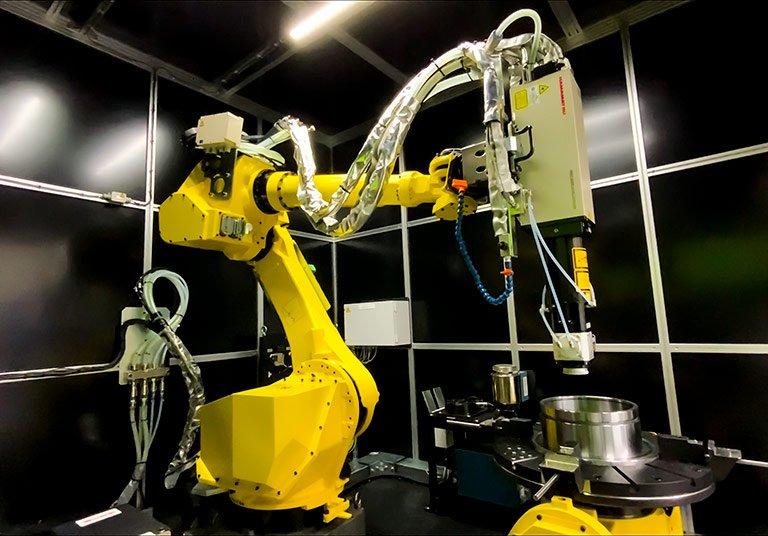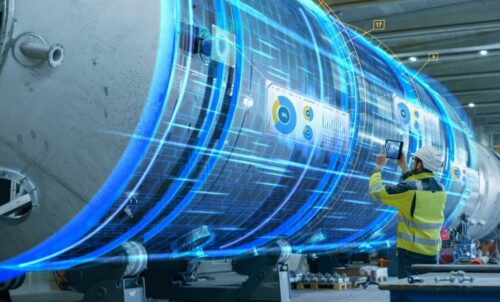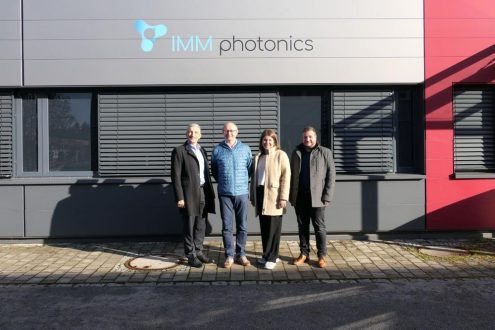
Hamamatsu Photonics has developed laser thermal processing equipment capable of operating with a high degree of freedom while emitting continuous to pulsed irradiation with a minimum pulse width of 4 milliseconds
This equipment was designed and developed via a project called "Development of Advanced Laser Processing with Intelligence Based on High-Brightness and High- Efficiency Next-Generation Laser Technologies" supported by NEDO (New Energy and Industrial Technology Development Organization), a major national research and development agency in Japan.
*1. Pulsed irradiation: Laser pulses are repeatedly emitted at very short time intervals. Lasers are broadly divided into pulsed lasers and CW (continuous wave) lasers that continuously emit laser light at a constant intensity.
Key features and benefits of our new product
Laser thermal processing equipment that combines a newly developed DDL with a 6-axis robotic arm.
・Emits laser light with a high degree of freedom at an average output power of 2.5 kW ideal for surface quenching.
・Allows setting any desired irradiation time from continuous to pulsed irradiation with a minimum pulse width of 4 milliseconds.
・Stabilizes the temperature of the irradiated area by temperature monitoring and feedback.
・Measures the temperature of the irradiated area in the range from 100°C to 2000°C without any physical contact.
・Emits a laser beam in 35 irradiation patterns with a uniform intensity distribution over the irradiated surface, enabled by our own unique optical design technology.
・Allows adjustment of the irradiation distance from the DDL to the target object in the range from 100 mm to 500 mm.
・Offers low running cost due to the use of the DDL.
Expected to promote the spread of laser quenching and expand its applications to materials with low heat resistance.
A Brief look at the product
This laser thermal processing equipment combines a newly developed DDL with a 6-axis robotic arm.
The DDL is a laser light source that condenses the laser beam emitted from the LD and irradiates it directly onto the target object. The DDL is easy to handle and its maintenance cost is low because no optical fibers are needed. We have already developed and produced various DDL and sell them for applications such as surface quenching, welding and brazing. This time, by applying the LD technology we have amassed over many years, we have developed a new DDL whose irradiation time and irradiation area can be flexibly adjusted as needed. We then combined it with a 6-axis robotic arm to design and develop new laser thermal processing equipment capable of operating with a high degree of freedom.
To drive the newly developed DDL, we also designed a power supply circuit from scratch that is optimized for laser output conditions. The DDL irradiation time can be set as needed from continuous irradiation to pulsed irradiation with a minimum pulse width of 4 milliseconds, while keeping an peak power of 2.5 kW. The laser output power is also automatically adjusted to stabilize the temperature of the irradiated area by monitoring the radiation temperature that is measured 500 times per second, with high accuracy in the range from 100°C to 2000°C without any physical contact, so that the temperature of the irradiated area can be precisely adjusted. Furthermore, due to our unique optical design technology, the DDL irradiates a laser beam in 35 patterns measuring from 2.5 mm long by 2.5 mm wide to 12.5 mm long by 62.5 mm wide while maintaining a uniform intensity distribution over the irradiated area. The irradiation distance from the DDL to the target object can be adjusted from 100 mm to 500 mm according to the shape and size of the target object.
This laser thermal processing equipment combines the newly developed DDL with a 6- axis robotic arm and can irradiate a laser beam onto steel materials of all shapes and sizes, and so will promote the increased use of laser quenching, which is a relatively new technique in the field of surface quenching. Moreover, this equipment is likely to be applied to materials with low heat resistance because the laser irradiation conditions can be flexibly adjusted as needed.
We will be working in collaboration with the TACMI Consortium(*2) to open up new applications for laser processing by continuing to give demonstrations of this processing technology together with the member companies involved with the materials processing industry.
*2. TACMI Consortium: This is an abbreviation for the Consortium for Technological Approaches toward Cool laser Manufacturing with Intelligence. The TACMI Consortium is managed mainly by the University of Tokyo to make the materials processing platforms provided by NEDO project participants widely available to industry, while aiming to promote manufacturing with new lasers that will meet the needs of the coming IoT era.
Development background
Surface quenching is a heat treatment method that strengthens the surface of steel material by heating it to a certain temperature or higher and then cooling it. Surface quenching is capable of increasing the hardness and fatigue strength of specific points and is therefore applied in manufacturing processes for steel parts used in transportation equipment and industrial machinery.
A common method for surface quenching is induction hardening that utilizes a highfrequency coil to heat the surface of steel material. Laser quenching, on the other hand, uses a laser as the heating source that can instantaneously heat just the irradiated area and also skips the cooling process. Fiber lasers that amplify the energy in the optical fiber are beginning to be used for laser quenching. As the laser heating method does not need optical fibers that require careful handling, DDL is also being put to practical use due to its simple device configuration and low running costs. To promote the spread of laser quenching, there have been increasing demands for thermal processing equipment that operates with a high degree of freedom and irradiates the DDL beam onto steel materials in all different shapes and sizes.
About the project
Future manufacturing sites are expected to make further use of AI (artificial intelligence)
and IoT (Internet of Things) where all things are connected via the Internet in order to make advances in the fields of automation and unmanned operation. Laser processing is promising as a vitally important tool for future manufacturing because laser irradiation intensity and time are easy to control. However, currently used lasers still face a number of challenges related to wavelength, output power, beam quality, and efficiency, etc.
This project is intended to promote the development of laser technology that offers unprecedented high efficiency, high output power, and high beam quality. It also aims to spread this technology to manufacturing sites well ahead of other countries in the world in order to reduce greenhouse gas emissions and strengthen the competitiveness of the Japanese manufacturing industry.
Hamamatsu Photonics Deutschland GmbH
Arzberger Str. 10
82211 Herrsching am Ammersee
Telefon: +49 (8152) 375-0
Telefax: +49 (8152) 375-199
http://www.hamamatsu.com
Public Relations
Telefon: +49 (8152) 375-185
Fax: +49 (8152) 375-199
E-Mail: rfritsch@hamamatsu.de
![]()





